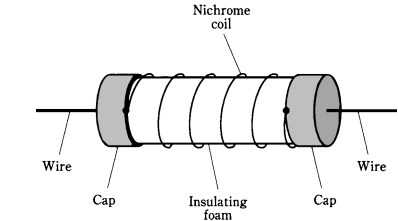wirewound resistor
A more obvious way to get resistance is to use a length of wire that isn't a good conductor. Nichrome is frequently used for this purpose. The wire can be wound around a cylindrical form, like a coil. The resistance can be determined by how well the wire metal conducts, by the diameter of it or gauge, and by the length of it. This component is known as wire- wound resistor.

Figure-- Construction of a wirewound resistor.
One of the advantages of wirewound resistors is that they can be made to have values within very close range; which means that, they are precision components. The other advantage is that wirewound resistors can be made to handle large amounts of power. Some wirewounds might do well as electric heaters, dissipating hundreds, or thousands of watts.
A disadvantage of the wirewound resistors, in some of the applications, is that they behave like inductors. This makes them unsuitable for use in the most radio-frequency circuits. Wirewound resistors have low to moderate values of resistance generally.